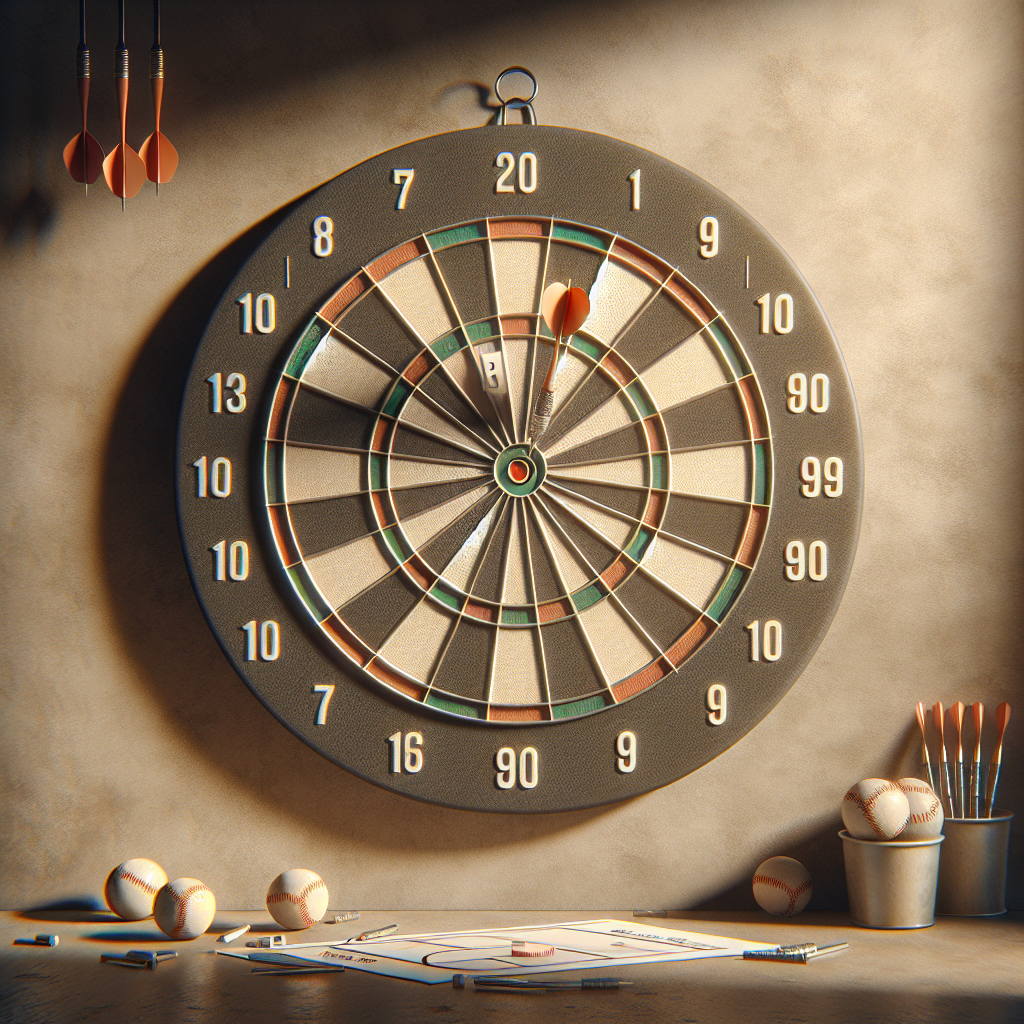Understanding Baseball Dart Games
Baseball Dart Games are a popular variation of darts that follow the rules and scoring system of baseball. In this section, we will explore the basics of the game as well as the scoring system.
Basics of the Game
In baseball dart games, the objective is to score runs by hitting numbers 1 through 9 in order before hitting a double of that number to advance to the next inning. The game consists of 9 innings, just like a real game of baseball.
Each player takes turns throwing three darts per inning. The inning number corresponds to the target segment for that inning. To score runs, players must hit the current inning’s target number. It’s important to note that runs are not multiplied by the inning number (GLD Products).
A perfect inning in baseball dart games occurs when a player hits three trebles on that inning’s target, resulting in 9 runs. A perfect game is achieved by scoring 81 runs, hitting the maximum number of runs possible throughout the game.
Scoring System
In baseball dart games, points are awarded based on the numbers hit on the dartboard. The scoring system is as follows:
- Hitting the outer ring of the target number awards 2 points.
- Hitting the inner ring of the target number awards 3 points.
The score is recorded after each player’s turn, and the player or team with the highest score at the end of the 9th inning wins the game. If the game is tied after 9 innings, extra innings are played where each subsequent inning corresponds to the next number on the dartboard until a clear winner is determined.
Understanding the basics and the scoring system of baseball dart games is essential before diving into the gameplay. Next, let’s explore how to play baseball darts, including the game setup, scoring mechanics, and how to win the game.
How to Play Baseball Darts
Baseball darts is an exciting game that combines the rules of baseball with the precision of darts. In this section, we will explore the game setup, scoring mechanics, and how to win the game.
Game Setup
To play baseball darts, you’ll need a standard dartboard and a set of darts. The game is typically played by two players or two teams. Each player or team takes turns throwing three darts per inning.
The innings in baseball darts correspond to the numbers on the dartboard. The game consists of 9 innings, just like a real baseball game. In each inning, players aim for a specific number on the dartboard, starting with number 1 and moving to the next number each inning.
Scoring Mechanics
In baseball darts, points are awarded based on hitting the correct number on the dartboard. Two points are awarded for hitting the outer ring (single) of the current inning’s target number, while three points are awarded for hitting the inner ring (triple).
For example, if the current inning is the second inning (target number is 2), hitting the outer ring of the number 2 will earn the player or team two points. Hitting the inner ring of the number 2 will earn them three points.
Winning the Game
The objective of baseball darts is to score the highest number of runs by the end of the 9th inning. A run is earned by hitting the current inning’s target number. Runs are not multiplied by the inning number, so a run in the first inning is worth the same as a run in the ninth inning.
If the game is tied after the 9th inning, extra innings are played. In extra innings, each subsequent inning corresponds to the next number on the dartboard until a clear winner is determined. The player or team with the highest score at the end of the extra innings wins the game.
Perfecting Your Throws
In baseball darts, a perfect inning occurs when a player hits three triples on the target number for that inning, resulting in 9 runs. A perfect game is achieved by scoring a total of 81 runs (GLD Products).
To improve your throws and increase your chances of scoring runs, practice your aim and work on your consistency. Pay attention to your grip, stance, and release to ensure a smooth and accurate throw.
Handling Ties
If the game is tied after the 9th inning, extra innings are played until a clear winner is determined. Each extra inning corresponds to the next number on the dartboard. This ensures that there is a fair chance for both players or teams to secure a victory.
Game Variations
One popular variation of baseball darts is the inclusion of a “7th inning stretch.” In this variation, if a player or team fails to score a run in the 7th inning, their entire score is halved. This adds an element of risk and strategy to the game, as players must carefully consider their approach in the 7th inning to avoid losing half of their hard-earned score.
By understanding the game setup, scoring mechanics, and strategies for success, you can fully enjoy the thrill of baseball darts. Gather your friends or family, set up the dartboard, and have a fantastic time playing this engaging and competitive game.
Strategies and Variations
To excel in baseball dart games, it’s important to develop effective strategies and be familiar with various game variations. These can enhance your gameplay experience and add excitement to the competition.
Perfecting Your Throws
Mastering the art of throwing darts is essential for success in baseball dart games. Here are some tips to help you improve your throws:
- Aim for the specific target areas that will maximize your score. In baseball darts, hitting certain sections of the dartboard can earn you different scores, such as singles, doubles, triples, and home runs. Understanding the scoring system and practicing your aim will greatly increase your chances of achieving higher scores.
- Develop consistent throwing techniques. Focus on your stance, grip, and release to ensure consistent and accurate throws. Practice regularly to fine-tune your technique and develop muscle memory.
- Control your strength and speed. Adjust the force behind your throws to achieve the desired accuracy. Experiment with different throwing styles and find what works best for you.
- Stay calm and focused. Maintaining a calm and focused mindset during gameplay is crucial. Avoid distractions and concentrate on your target.
Handling Ties
In baseball darts, ties can occur when players or teams have the same score at the end of the 9th inning. To break the tie and determine a clear winner, several options are available:
- Extra innings: If the game is tied after the 9th inning, additional innings can be played. Each subsequent inning corresponds to the next number on the dartboard. For example, in the 10th inning, players aim for the number 10 segment, in the 11th inning, they aim for the number 11 segment, and so on. This continues until a clear winner is determined.
- Numbered segments: Players can continue the game by aiming at numbered segments starting from 10 and onwards. The first player to achieve a higher score than their opponent wins the game.
- Bullseye challenge: Each player gets three throws at the bullseye. The outer bull counts as one run, while the bullseye itself counts as two runs. The player who scores the most runs in this challenge breaks the tie and wins the game.
Game Variations
To add variety and challenge to your baseball dart games, consider exploring different game variations. Here are a few popular options:
- 7th inning stretch: In this variation, if a player fails to score a run in the 7th inning, their entire score is halved. This adds an element of risk and strategy to the game, as players must carefully strategize their throws to avoid losing half of their score.
- Team play with a dummy player: In team play, if the teams are uneven, a dummy player with a predetermined score (such as 5, 10, or 15) can be included to balance out the scoring. The dummy player’s score is divided equally among the innings, ensuring fairness in the game (Dart Help).
Exploring these variations can make your baseball dart games more engaging and enjoyable. Don’t be afraid to experiment and modify the rules to suit your preferences and create your own unique variations. Remember, the key is to have fun while challenging your dart skills.
Dartball: The Fusion Game
Dartball is an intriguing American darts game that combines elements of darts and baseball. It is typically played on a large wooden or homasote fiber wallboard that resembles a baseball field, complete with colored areas denoting the bases. The rules and scoring system of Dartball are based on American Baseball, adding an exciting twist to the traditional game of darts.
Introduction to Dartball
Dartball games are commonly played in leagues during the autumn and winter months in church common areas or basements. Teams typically consist of seven or nine players along with alternates, coming together to compete in this unique fusion game (Darts501).
The origins of Dartball can be traced back to the early 1920s when the Apex company introduced the first Dartball board in 1923. By 1928, Dartball Leagues had been established, with strongholds of the sport reported in cities such as Philadelphia, Kansas City, and Milwaukee by 1941 (Darts501).
Rules and Gameplay
Dartball utilizes wooden darts with real feathers and metal tips, similar to the darts used in the French game of “Flechettes.” The dartboard used in Dartball consists of a four-base diamond, additional areas marked for various plays, and a six-inch foul line border (Darts501).
In Dartball, players stand at the pitcher’s line, which is usually positioned 20-25 feet away from the dartboard. The objective is to throw the darts towards the playing field, aiming to land on the bases or specific areas to score runs. The game typically consists of three nine-inning matches, mirroring the structure of a baseball game. At the end of the three matches, the team with the highest total runs wins the game (Darts501).
Dartball requires precision, strategy, and a combination of dart-throwing skills and baseball-inspired gameplay. It offers a unique and entertaining experience for darts enthusiasts looking for a fresh twist on the traditional game.
For more information about other dart games, rules, and variations, be sure to explore our articles on cricket dart game rules, dart games rules, 301 dart game rules, and popular dart games.
History and Evolution
The game of Dartball has a rich history and has evolved over time. In this section, we will explore the origins of Dartball, the establishment of Dartball leagues, and the equipment used in this unique darts game.
Origins of Dartball
Dartball is an American darts game that combines elements of darts and baseball. It is typically played on a large wooden or homasote fiber wallboard that resembles a baseball field, with colored areas denoting bases. The rules and scoring system of Dartball are based on American Baseball.
The first Dartball board was introduced by the Apex company in 1923. By early 1928, Dartball leagues were established, and the sport began gaining popularity. Strongholds of Dartball were reported in cities like Philadelphia, Kansas City, and Milwaukee by 1941 (Darts501).
Dartball Leagues
Dartball games are usually played in leagues during the autumn and winter months. These leagues are commonly held in church common areas or basements. Teams typically consist of seven or nine players, along with alternates. The league format adds a competitive element to the game, fostering a sense of camaraderie and friendly competition among players.
Dartball Equipment
The equipment used in Dartball differs from traditional darts. Dartball utilizes wooden darts with real feathers and metal tips, similar to the darts used in the French game of “Flechettes.” The dartboard used in Dartball consists of a four-base diamond, with additional areas marked for various plays. A six-inch foul line border is also included for accurate positioning during throws (Darts501).
The unique equipment and specialized dartboard create an immersive experience for players, blending the precision of darts with the strategy and scoring system of baseball.
As Dartball continues to be played in leagues and enjoyed by enthusiasts, it remains a distinct and captivating variation of the traditional game of darts. Whether you’re a seasoned player or new to the game, Dartball offers a unique and exciting way to test your skills and enjoy the thrill of competition.
Dartball vs. Baseball Darts
When it comes to dart games inspired by baseball, two popular variations are Dartball and Baseball Darts. While both games share similarities, there are key differences that set them apart.
Key Differences
-
Scoring System: In Baseball Darts, the game consists of 9 innings, with players aiming for specific numbers on the dartboard each round. The number targeted corresponds to the current inning, and points are awarded for hitting the right number, with 2 points for the outer ring and 3 points for the inner ring of the right number (GLD Products). Dartball, on the other hand, involves throwing darts towards a playing field from a pitcher’s line to score runs on bases or specific areas (Darts501). The game is played in three nine-inning matches, and the team with the most runs at the end wins.
-
Equipment: Baseball Darts typically uses traditional darts with metal tips and plastic flights. The scoring is based on hitting specific segments of the dartboard. In contrast, Dartball utilizes wooden darts with real feathers and metal tips, resembling the darts used in the French game of “Flechettes”. The dartboard for Dartball features a four-base diamond, additional areas for various plays, and a six-inch foul line border.
-
Playing Environment: Baseball Darts can be played in various settings, including bars, arcades, and homes. It is a popular choice for casual dart enthusiasts looking for a fun twist on the traditional game. Dartball, on the other hand, is often played in leagues during the autumn and winter months in church common areas or basements (Darts501). It is commonly enjoyed by teams of seven or nine players, with alternates available.
Similarities and Crossover
Despite their differences, both Dartball and Baseball Darts share a common theme of incorporating elements of baseball into the game of darts. In both games, players aim to score runs or points by hitting specific targets on the dartboard. The concept of innings and rounds is present in both games, adding a strategic element and mirroring the structure of a baseball game.
For enthusiasts of dart games and baseball, these variations provide an exciting crossover experience. Whether you prefer the precision of Baseball Darts or the strategic gameplay of Dartball, both games offer a unique and enjoyable way to combine the thrill of darts with the spirit of America’s favorite pastime.
For more information on other dart games and variations, be sure to check out our articles on cricket dart game rules, 301 dart game rules, and different types of dart games.








